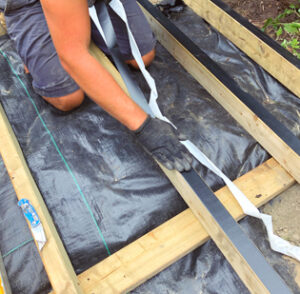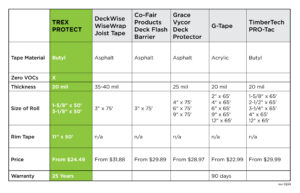What is Deck Joist Tape? A Complete Overview
By Dave KileAs someone who’s spent decades in the decking industry, I’ve seen—and been a proud part of—a lot of innovation, especially in how we preserve and extend the life of our decks. Today, the focus is not only on the aesthetic aspects like materials and finishes but also on ensuring we protect every part of the deck from the elements. This broader approach to deck durability is where deck joist tape plays a vital role. Let’s take a look at what deck joist tape is, its importance, and how you can use it to enhance your deck’s longevity.
What is Deck Joist Tape?
 Deck joist tape is a self-adhesive tape that’s applied to the top of joists before laying down the decking boards. It creates a moisture-resistant barrier that protects deck joists from water penetration—a common cause of rot and decay that can threaten the structural integrity of your deck. The tape, which is usually black in color, comes in rolls with a release backing.
Deck joist tape is a self-adhesive tape that’s applied to the top of joists before laying down the decking boards. It creates a moisture-resistant barrier that protects deck joists from water penetration—a common cause of rot and decay that can threaten the structural integrity of your deck. The tape, which is usually black in color, comes in rolls with a release backing.
Types of Deck Joist Tape
There are two main types of deck joist tape commonly used in deck construction:
Butyl Tape
 Butyl tape is a favorite for its stickiness and flexibility, making it the go-to choice for many deck builders, myself included. It adheres tightly while also sealing around fasteners to keep water out and prevent corrosion. Butyl tapes can handle scorching summers and freezing winters, naturally expanding and contracting with the seasons while maintaining a durable seal.
Butyl tape is a favorite for its stickiness and flexibility, making it the go-to choice for many deck builders, myself included. It adheres tightly while also sealing around fasteners to keep water out and prevent corrosion. Butyl tapes can handle scorching summers and freezing winters, naturally expanding and contracting with the seasons while maintaining a durable seal.
Asphalt Tape
Asphalt tape is another option and can be practical for those on a budget or working on projects in less demanding environments. While it offers decent moisture protection, I find it’s best suited for milder climates. Asphalt tape can become brittle in very cold temperatures and degrade under intense UV exposure, making it less suitable for areas with extreme weather.
Benefits of Using Joist Tape
For me, applying joist tape is essential. This preventive measure offers multiple benefits to any deck project, so whether you’re building your own or planning to find a builder, I recommend including deck joist tape in your project. Here’s why I always make sure it’s part of the plan:
 Protection Against Moisture and Rot
Protection Against Moisture and Rot
Deck joist tape creates a waterproof barrier that seals the top surfaces of your joists, preventing moisture from seeping into the wood. The barrier helps prevent rot and decay caused by damp conditions.
Extension of Deck Lifespan
By shielding the wooden components of your deck from moisture, deck joist tape prolongs its life. In moist environments, untreated wood deck joists can begin to weaken and deteriorate within just a few years. Using deck joist tape helps prevent this early decay, so your deck remains strong and safe.
Cost Savings on Maintenance and Repairs
The initial investment in deck joist tape is relatively modest but can save homeowners considerable money over time. By preventing rot and structural weakening, the need for substructure repairs—or even full deck replacement—is drastically reduced. Investing in deck joist tape when you build helps safeguard your outdoor retreat for years to come.
Enhanced Structural Integrity
By protecting joists against moisture, joist tape helps maintain your deck’s structural integrity. Some high-quality butyl tapes, like Trex Protect, offer added benefits such as helping deck screws hold longer and stronger, and eliminating splitting from freeze and thaw cycles.
How to Apply Deck Joist Tape
 Applying deck joist tape is straightforward, but there are tips to ensure optimal coverage and protection:
Applying deck joist tape is straightforward, but there are tips to ensure optimal coverage and protection:
- Clean the Joist Surfaces: To help the tape adhere strongly, sweep or wipe the joists clean and check that they’re completely dry and free from debris.
- Apply the Tape: Start at one end and unroll the tape directly onto the joists. Align the end of the tape carefully and maintain tension to avoid wrinkles as you apply it along the joist. Peel the liner away as you go.
Pro Tip: Cover all butt joints by overlapping the tape where joists meet the rim board or blocking. This prevents damaging moisture from penetrating these vulnerable areas of your deck.
- Cut the Tape: Use a utility knife to cut the tape to length.
Pro Tip: Avoid excess material at the ends, which can lead to peeling or debris accumulation.
- Press Down Firmly: After applying the tape, run your hand or a small roller over it to press the tape firmly into the wood surface to make sure it fully adheres with no air bubbles or loose edges.
To see a deck joist tape application in action, check out this video:
Choosing the Right Deck Joist Tape
When selecting the best deck joist tape for your project, it’s important to consider several key factors:
- Climate Suitability: Choose a joist tape that remains flexible and adhesive, even in low temperatures. Butyl-based tapes are known for their low-temperature performance and thermal stability, which prevent cracking or lifting. If severe weather isn’t a concern, asphalt tape may be adequate.
- Installation Ease: Butyl tape is often easier to install, thanks to its strong initial tack that minimizes the need for repositioning. Asphalt tape, while easy to handle due to its less aggressive adhesive, requires more careful placement and securing to ensure a reliable seal.
- Thickness: Thicker tapes can provide a durable barrier against moisture and wear but are more challenging to apply. I prefer a thickness that balances ease of application with protective performance. Butyl tapes come in a variety of thicknesses while thinner asphalt tape may require careful handling to avoid tearing, especially in cooler conditions where the material may be less flexible.
- Affordability and Value: Butyl tape is generally more expensive upfront, but its durability and the extent of protection it offers can make it more cost-effective in the long run by preventing repairs and replacements. Asphalt tape can be a budget-friendly option in mild conditions.
 For a joist tape that excels in all climates and conditions, I depend on Trex Protect. This butyl-based tape provides an exceptional seal that guards against moisture, prevents decay, and seals around screws to strengthen their hold. Plus, it comes with an industry-leading 25-year warranty. When deciding on a joist tape, be sure to check out my best joist tape comparison.
For a joist tape that excels in all climates and conditions, I depend on Trex Protect. This butyl-based tape provides an exceptional seal that guards against moisture, prevents decay, and seals around screws to strengthen their hold. Plus, it comes with an industry-leading 25-year warranty. When deciding on a joist tape, be sure to check out my best joist tape comparison.
Conclusion
Investing in quality joist tape might seem like a minor detail, but it’s a crucial decision that significantly extends the life of your deck. Deck joist tape safeguards your deck’s structural integrity by effectively shielding the critical framing from moisture. This small step translates into long-lasting enjoyment and peace of mind. Incorporate joist tape into your project to ensure your deck remains safe, strong, and durable.
Sources
DecksDirect. (n.d.). Joist Tape: When, How, and Why You Should Use It. Retrieved from https://www.decksdirect.com/learning-center/deck-building-resources/joist-tape-when-how-and-why-you-should-use-it
Fine Homebuilding. (2024, October 13). Framing and Flashing a Small Deck. Retrieved from https://www.finehomebuilding.com/2024/10/13/framing-and-flashing-a-small-deck